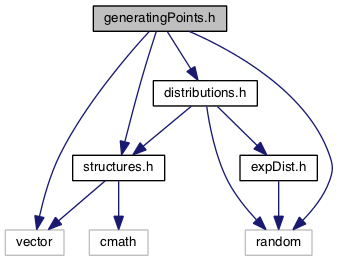

Go to the source code of this file.
Functions | |
| std::vector< Point > | discretizeLineOfIntersection (double *pt1, double *pt2, double dist) |
| struct Point | lineFunction3D (double *v, double *point, double t) |
| double * | fisherDistribution (double theta, double phi, double kappa, std::mt19937_64 &generator) |
| double * | randomTranslation (std::mt19937_64 &generator, float xMin, float xMax, float yMin, float yMax, float zMin, float zMax) |
| float | truncatedPowerLaw (float randomNum, float emin, float emax, float alpha) |
| void | generateTheta (float *&thetaArray, float aspectRatio, int nPoints) |
| bool | greaterThan (float i, float j) |
Function Documentation
§ discretizeLineOfIntersection()
| std::vector<Point> discretizeLineOfIntersection | ( | double * | pt1, |
| double * | pt2, | ||
| double | dist | ||
| ) |
Discretizes intersetion Arg 1: End point 1, array of three doubles {x, y, z} Arg 2: End point 2, array of three doubles {x, y, z} Return: List of 3D points of the discretized nodes, including end points
Definition at line 18 of file generatingPoints.cpp.


§ fisherDistribution()
| double* fisherDistribution | ( | double | theta, |
| double | phi, | ||
| double | kappa, | ||
| std::mt19937_64 & | generator | ||
| ) |
Creates and returns an x,y,z array of doubles using fisher distribution.
NOTE: Uses new[] to return an array. NEED TO USE delete[] TO FREE THE MEMORY AFTER USE
Arg 1: theta, the angle the normal vector makes with the z-axis Arg 2: phi, the angle the projection of the normal onto the x-y plane makes with the x-axis Arg 3: kappa, parameter for the fisher distribnShaprutions Arg 4: Random generator, see std c++ <random> library Return: A fisher distribution array {x, y, z}. Used for random generation of polygon normal vectors.
Definition at line 93 of file generatingPoints.cpp.


§ generateTheta()
| void generateTheta | ( | float *& | thetaArray, |
| float | aspectRatio, | ||
| int | nPoints | ||
| ) |
Integrate diff eq for theta as function of arc length using RK2 Used once for each ell family, saves theta array to shape structures Arg 1: OUTPUT, Theta array used for ellipse generation Arg 2: Aspect ratio of ellipse family Arg 3: Number of points being used for ellipse family
Definition at line 224 of file generatingPoints.cpp.

§ greaterThan()
| bool greaterThan | ( | float | i, |
| float | j | ||
| ) |
Used for sort() in generateRadiiLists() Compares two floats.
Arg 1: float i Arg 2: float j Return: True if i > j False otherwise
Definition at line 263 of file generatingPoints.cpp.

§ lineFunction3D()
| struct Point lineFunction3D | ( | double * | v, |
| double * | point, | ||
| double | t | ||
| ) |
Returns a point on the line/vector v at point t, 0 <= t <= 1 Arg 1: Array of three doubles {x, y, z}, vector of line segment Arg 2: Array of three doubles {x, y, z}, end point on line Arg 3: t, 0<= t <= 1 Return: Point on line
Definition at line 72 of file generatingPoints.cpp.

§ randomTranslation()
| double* randomTranslation | ( | std::mt19937_64 & | generator, |
| float | xMin, | ||
| float | xMax, | ||
| float | yMin, | ||
| float | yMax, | ||
| float | zMin, | ||
| float | zMax | ||
| ) |
Uses new[] to pass a vector/array. NEED TO USE delete[] TO FREE THE MEMORY AFTER USE Arg 1: Random generator, see std c++ <random> library Arg 2: minimum x for random x Arg 3: maximum x for random x Arg 4: maximum y for random y Arg 5: minimum y for random y Arg 6: maximum z for random z Arg 7: minimum z for random z Return: Pointer to random ranslation, array of three doubles {x, y, z}
Definition at line 177 of file generatingPoints.cpp.

§ truncatedPowerLaw()
| float truncatedPowerLaw | ( | float | randomNum, |
| float | min, | ||
| float | max, | ||
| float | alpha | ||
| ) |
Distrubution function for truncated power-law randomNum must be between 0 and 1 This distribution should be sampled uniformly between 0 and 1 to produce a truncated power-law distribution Arg 1: Random variable between 0 and 1 Arg 2: Minimum number which can be returned from the distribution Arg 3: Maximum number which can be returned from the distribution Arg 4: Power-law's alpha Return: Random float adhering to the truncated power law distribution
Definition at line 208 of file generatingPoints.cpp.
